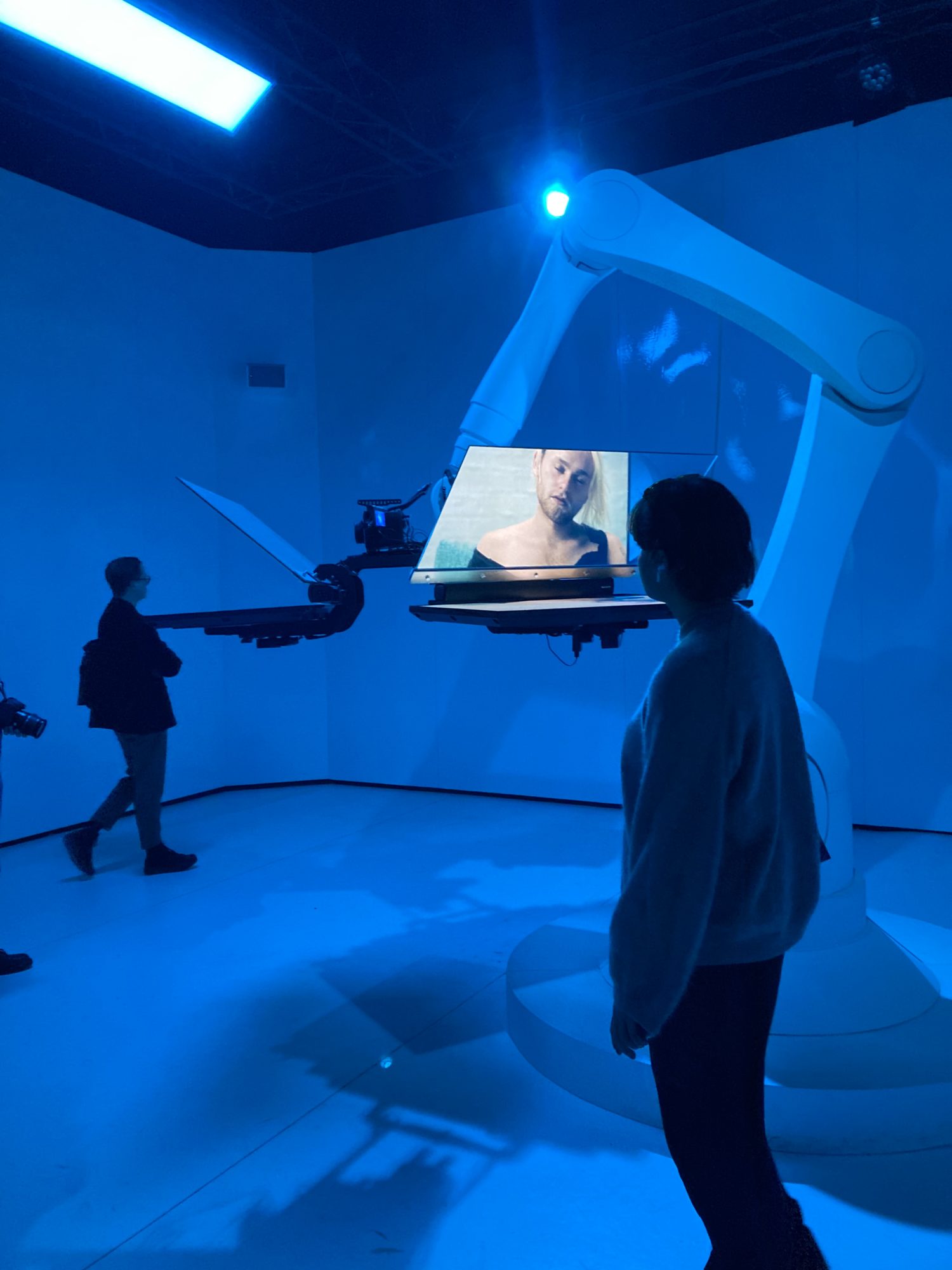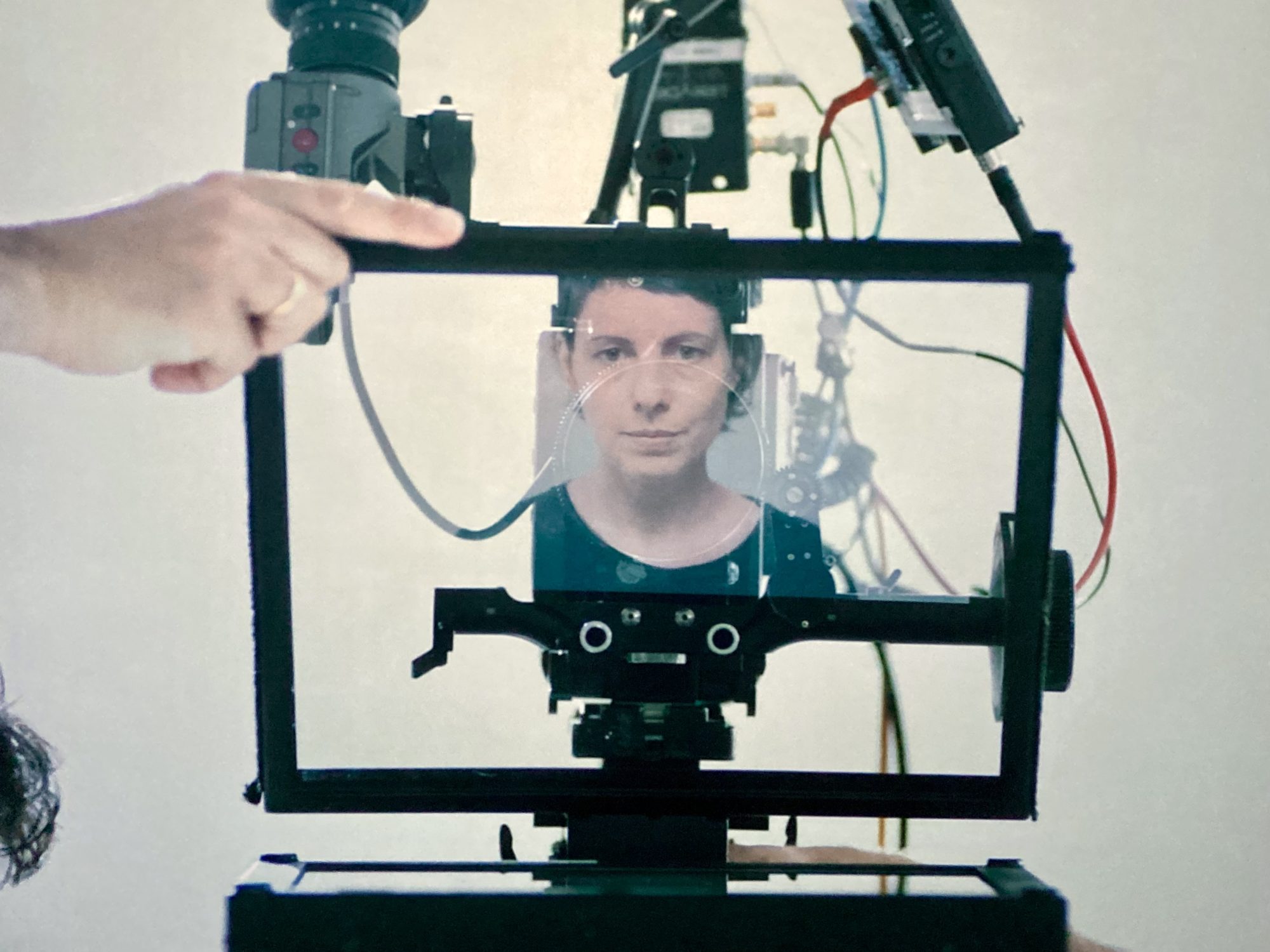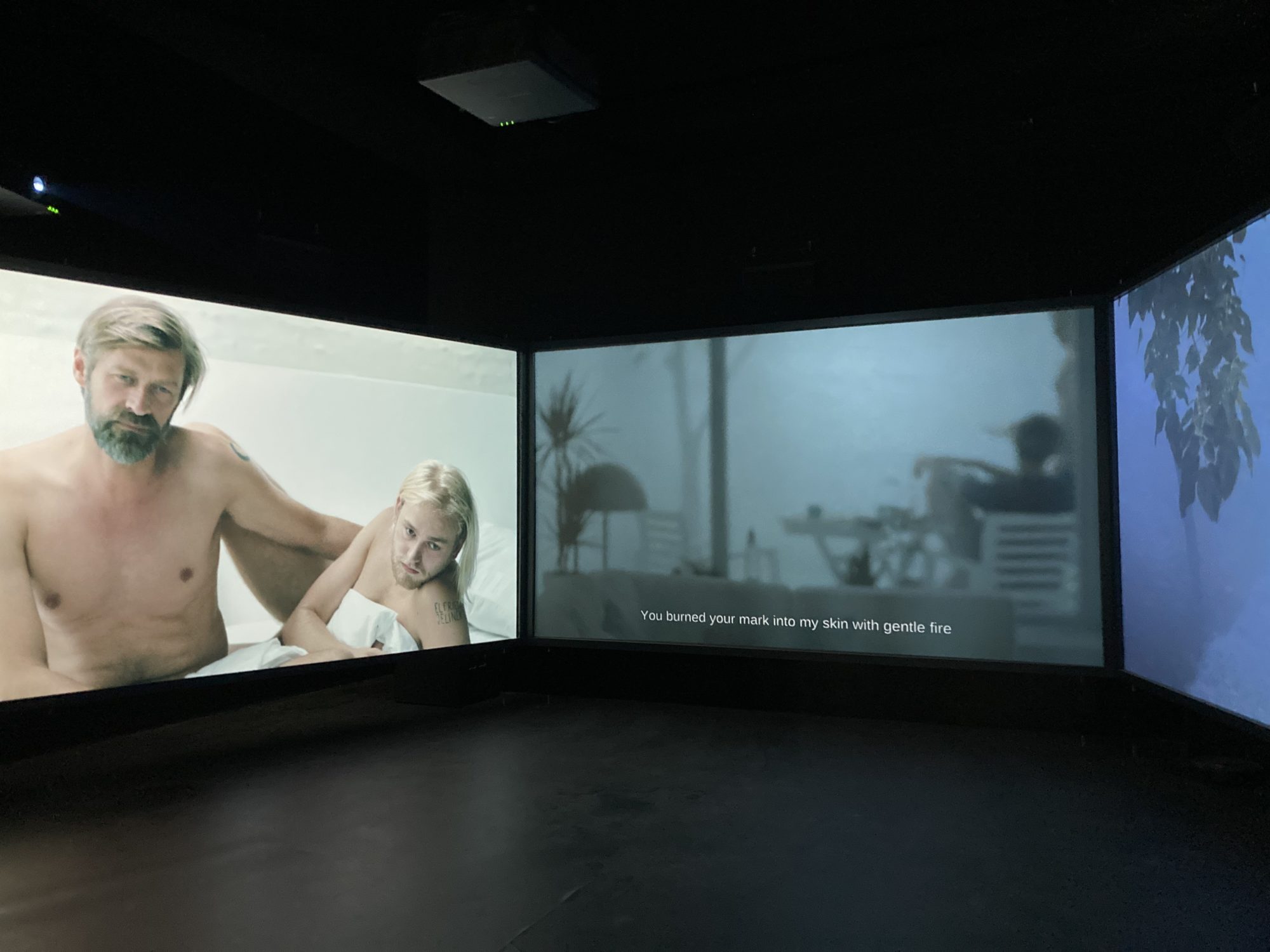Investigating Intimacy: Adina Pintilie’s project for the Romanian Pavilion
At the 59th edition of the Venice Biennale, Romania is represented by the artist and filmmaker Adina Pintilie with the project You Are Another Me—A Cathedral of the Body. Curated by Cosmin Costinaș and Viktor Neumann, the project consists of a multi-channel video installation at the Romanian Pavilion, and a virtual-reality extension hosted by the New Gallery of the Romanian Institute for Culture and Humanistic Research.

Adina Pintilie, You Are Another Me—A Cathedral of the Body, exhibition view, Romanian Pavilion at the 2022. Venice Biennale Image courtesy Giulia Gelmi. Photo: Giulia Gelmi.
Through the representation of intimacy and sexuality, the artist confronts and overcomes the concept of the normative, standardized, and performative body, while investigating its relationship with current conversations on gender identity, bodily diversity, and representational plurality. Born in 1980 in Bucharest, Pintilie is a visual artist, filmmaker, and curator working between Germany and Romania, whose works have been screened at major international festivals and won numerous awards. Her research on the politics, poetics, and ethics of intimacy and sexuality was initiated with the feature film Touch Me Not, a psychological inquiry into human desire and winner of the Golden Bear at the 2018 Berlinale. The Biennale exhibition project demonstrates the next stage of Pintilie’s investigation. In a generative limbo between documentary, fiction, and the visual arts, the artist’s long-term and trans-disciplinary inquiry explores how we relate to each other and our bodies through different languages and mediums.
From the project’s title, it is possible to frame the exhibition’s central themes. The English translation of the Mayan greeting Lak’ech Ala K’in, You Are Another Me, draws attention to the body’s relational dimension, which is embodied in non-judgmental, caring, and mutually affectionate forms of relationality and empowerment. Meanwhile, the proposition A Cathedral of the Body focuses on the need to critically reposition the body, and its role, in today’s political and cultural discourse and to celebrate it.
Hosted at the Venice Giardini, inside the Romanian Pavilion, the main exhibition consists of two adjoining spaces. From the entrance, one enters a dark and spacious room occupied by a nine-channel video installation that the visitor is encouraged to experience in its entirety. In a nonlinear narrative, the 45-minute video installation focuses on three main themes: a homosexual couple’s relational dynamics; the female body, with its attributes, which raises the question of what it means to be a woman; and the experience of sexuality and pleasure from a non-normative bodily perspective. The bodies are nude, without filters or embellishments. On the screen, the people involved kiss, touch, and talk, sharing, among them and with us, their fantasies, discomforts, insecurities, and desires. The video evolves around Pintilie’s community of long-term collaborators, spanning across countries, generations, and backgrounds: performers Hermann Müller and Dirk Lange, disability rights activists Christian Bayerlein and Grit Uhlemann, performer and teacher Laura Benson, transgender activist and sex worker Hanna Hofmann.

Adina Pintilie, You Are Another Me—A Cathedral of the Body, exhibition view, Romanian Pavilion at the 2022. Venice Biennale Image courtesy Giulia Gelmi. Photo: Giulia Gelmi.
The camera observes and scrutinizes those in front of it, and we, as spectators, assume its point of view. We feel gently, but brazenly, admitted into worlds and experiences that do not belong to us. Nevertheless, the camera’s unperturbed eye catches every detail, and the close-up approach makes them immediately familiar to us. Such familiarity seems to derive, in part, from the imposing nature of the size of the screens and the immersive exhibition setting, and in part from the private dimension of the stories being told and the directness of the tones used. In this narrative construction, Pintilie has created a brilliant correspondence between vision and sound. The visitor moves freely from one space to another and is invited to move within the installation following the narrating voices, as the videos are automatically turned on and off.
In the center of the other room—a less spacious, but brighter and colorful space—is a mechanical arm, equipped with three screens that reflect their moving images on mirrors, forming a sort of teleprompter. The screening videos show the same characters as in the first room but in a more private dimension. The relationship is no longer limited to the viewer observing and the actor on the screen who is observed. The encounter with these mirrored images imposes a more direct and inquisitive stare. We are no longer just spectators but rather spatially and emotionally involved. In the clarity of this intimate space, we come face to face with the protagonists of the artwork. Their gaze now turns to us and reverses the perspective: it interrogates us, with our personal experiences, doubts, and vulnerabilities.
The research underpinning the project privileges non-verbal language. In Pintilie’s visual diaries, exchanging glances is merely the first point of contact between us and the people she portrays. The diaries aim to inquire about and highlight the cognitive and expressive possibilities of the body’s varied vocabularies and languages.

Adina Pintilie, You Are Another Me—A Cathedral of the Body, exhibition view, Romanian Pavilion at the 2022. Venice Biennale Image courtesy Giulia Gelmi. Photo: Giulia Gelmi.
Within this context, the skin is configured as a threshold between oneself—the chaotic microcosm that each of us represents—and others. Brushing, caressing, squeezing, slapping… By employing different ways of touching, as Pintilie’s work suggests, we can enter into communication and relationships with one another. Therefore, (consensual) “touch” becomes a fundamental tool for connecting, interacting, and understanding: a form of communication that comes—as the curators stated—”before words,” in a more straightforward and unfiltered way.
In line with a gradual process of overcoming the Western tradition of thought that sees the mind and the body opposed, and which has completely discredited corporeity, the Romanian artist seems to connect to Maurice Merleau-Ponty’s thought. In the latter’s works, the centrality of the physical body is conceived as an essential condition of knowledge.(Maurice Merleau-Ponty, Phénoménologie de la perception Paris: Gallimard, 1945); accessed in Maurice Merleau-Ponty, Fenomenologia della percezione, trans. Andrea Bonomi (Milan: Bompiani, 1965).) Seen, first of all, as an object “in the world,” then as “a way into the world,” the body represents the link to the reality in which we are immersed and a means of understanding it.(Simona Stano, “La soglia del senso,” in Massimo Leone, ed. Il programma scientifico della semiotica. Scritti in onore di Ugo Volli (Canterano, Rome, Italy: Aracne editrice, 2019): 147-160).)
In consideration of these theoretical assumptions, Pintilie’s artistic research appears to lay its foundations on two different, but intersecting, planes. On the one hand, the body is considered a place of intimacy, in its private and personal dimension; on the other hand, it configures as an agora, hence a public and political space. Between the individual and the collective dimensions, the body is the touchpoint where the image we have of ourselves and the image others have of us meet.
How much expectation and pressure have we loaded our bodies with? It is both a place of self-expression and affirmation, but also of appearance, conflict, and bias. As this burdened body does not respond to our expectations and the expectations of others, we do not recognize and reject it. For its part, it might become a terrible constraint. The artist invites us to accept and embrace our inherent fragility.
From a political point of view, other key themes in Pintilie’s immersive exhibition are those of “visibility,” as individuals and/or as part of a community; and national “representation.” Our bodies are not neutral entities: the body is a battlefield. The body situates us in a precisely connoted socio-cultural context, not only spatially, but metaphysically as well. According to the statement issued by the curators, Costinaș and Neumann, “today, once again, the body has become a contested site for ideologies, a pretext for cultural and political anxiety, brought to the extreme by the recent outbreak of an atrocious war on the European continent, motivated by an imperialist, nationalist ideology and fascist ethos.”(https://cathedralofthebody.com/en)
In a political context, both national and international, witnessing an increasing polarization of conflict and violence in public discourse, it is interesting to consider how the project relates to the history of contemporary Romania and the question of national representativeness within an institutional venue such as the Biennale. In response to the conservative and right-wing trend in Romania currently, the pavilion, whose architecture is still markedly defined by the fascist style, is transformed by Pintilie’s site-specific intervention into a place of open dialogue, respect for personal freedom and human connection. Working with respect to and in support of minorities and diversity, the artist consciously addresses and challenges the narratives of institutionalized normativity. Even though not explicitly connoted from a political point of view, the bodies she makes visible affirm the need to overcome heteronormative, able-bodied regimes; broaden the spectrum of representation; and ensure spaces of socio-political agency that are not dominated by homologating, stereotyped, and pathologizing perspectives.

Adina Pintilie, You Are Another Me—A Cathedral of the Body, exhibition view, Romanian Pavilion at the 2022. Venice Biennale Image courtesy Giulia Gelmi. Photo: Giulia Gelmi.
Themes of visibility and representativeness are not the only urgent and critical issues that the project’s complexity and layered nature enable us to tackle. The artist’s work questions and enhances the body’s transformational and healing potential. In different ways, Pintilie’s collaborators explore intimacy together, relating to each other through a variety of embodied practices and psychological investigations. Her perspective and practice create a relational space, where restrictive boundaries and definitions blur. Through conversation, caring, dancing, or touching, You Are Another Me—A Cathedral of the Body strives to imagine “a contemporary site for the transgression of divisions towards mutual affection and devotion.”(https://cathedralofthebody.com/en) Unleashing the body’s potential, Pintilie guides us in a deeply human and intimate reflection on it, and on its role in the processes of shaping identity and building relationships with ourselves and others. In the sphere of individuality, the project touches on themes of self-discovery and pleasure, but also loneliness and codependency.
A complementary moment of reflection is represented by the virtual reality installation extension hosted in the New Gallery of the Romanian Institute for Culture and Humanistic Research. In this section of the project, the artist investigates the relationship between physical and virtual corporeity. The global pandemic of the last two years has pervasively accustomed us to physical distance and to a process of the two-dimensional flattening of reality. Using video, moving images, and Virtual Reality, Pintilie interrogates intimacy through the lenses of absence and the possibility of generating new forms and spaces of human interaction supported by advanced technologies.
The topical and militant character of the artist’s piece resonates in, and dialogues with, the works presented by other pavilions of the 59th Venice Biennale. Both located outside the official Biennale venues, the Dutch and the Portuguese exhibition projects share with the Romanian pavilion a common research ground. The Dutch pavilion, whose project is titled “When the body says Yes,” consists of an immersive video installation by Melanie Bonajo (they/them), artist, filmmaker, certified sexological bodyworker, and somatic sex coach. The installation is part of the artist’s ongoing research into “the status of intimacy in our increasingly alienating, commodity-driven world.” For Bonajo, “consensual touch can be a powerful remedy for the modern epidemic of loneliness.”(https://www.mondriaanfonds.nl/en/activities/venice-biennale/)
Curated by João Mourão and Luís Silva, the Portuguese pavilion displays the solo project “Vampires in Space” by visual artist, film director, and writer Pedro Neves Marques. The project, a science-fictionalized narrative installation—including a new film, unpublished poetry, and an immersive exhibition design—addresses, through the ambivalent figure of the vampire, issues of “gender identity, nonnuclear families, reproduction, and the role of mental health today.”(https://vampiresinspace.pt/eng/)
Pintilie’s voice joins that of many artists who perceive the issues raised today by corporeity as pressing. In an attempt to address these issues and give viewers space for collective reflection, the artists used the means available, employing art to play a key role. Against this background, Pintilie’s work results in a disenchanted and critically aware ode to the relational, cognitive, transformational, and political potential of the body. Placing intimacy at the center of the discourse becomes a tool for shaping a shared space of solidarity, respect, and reciprocal understanding.




